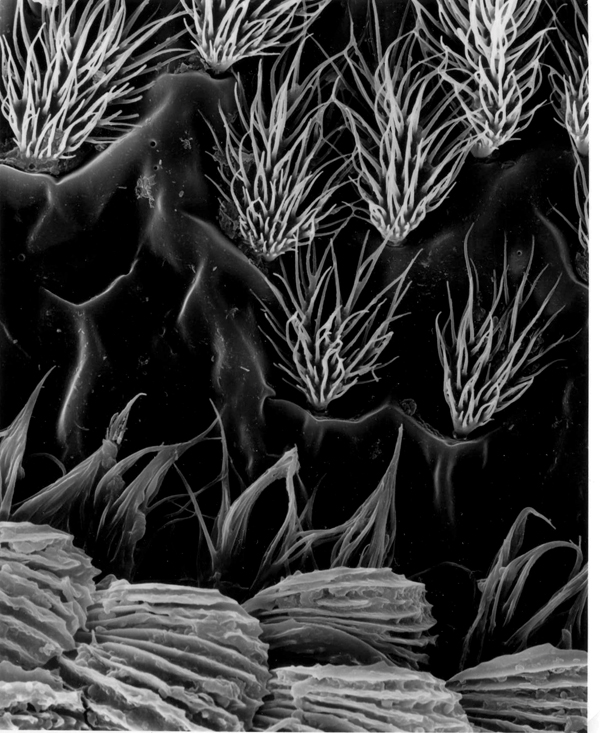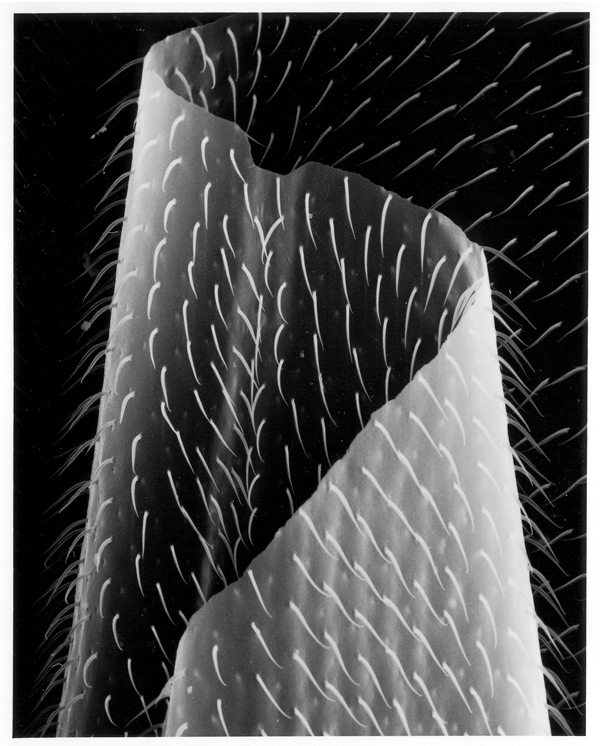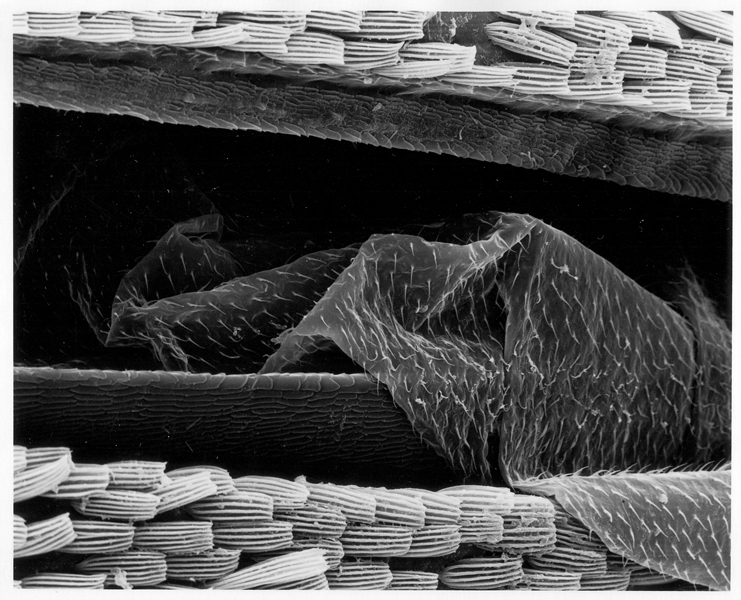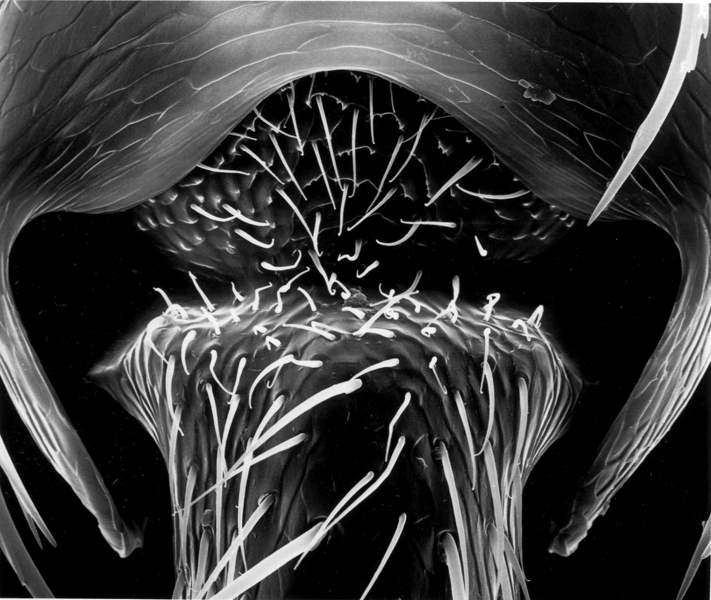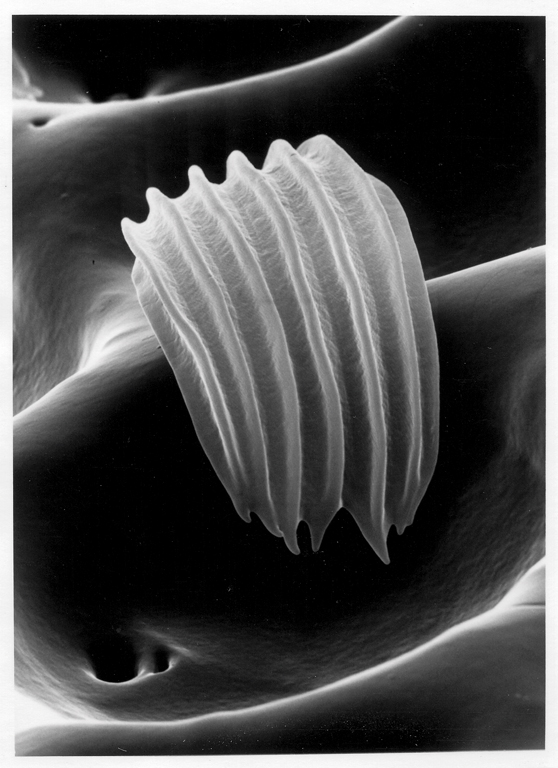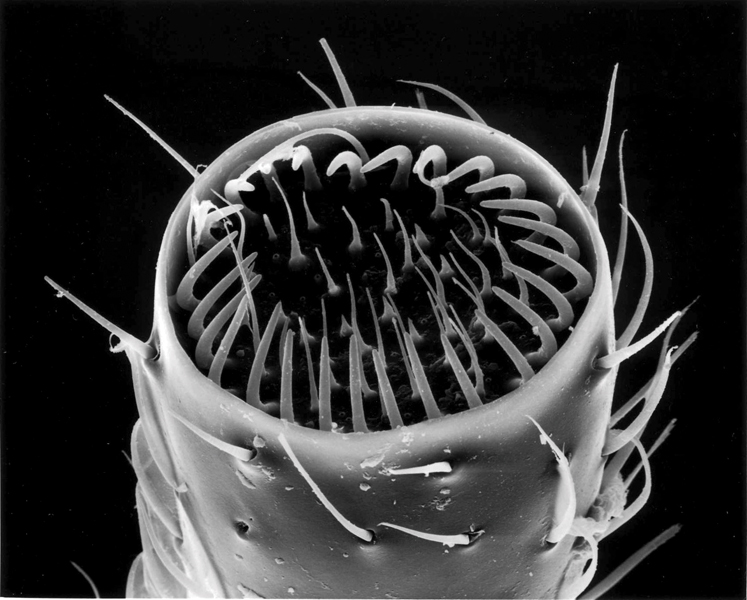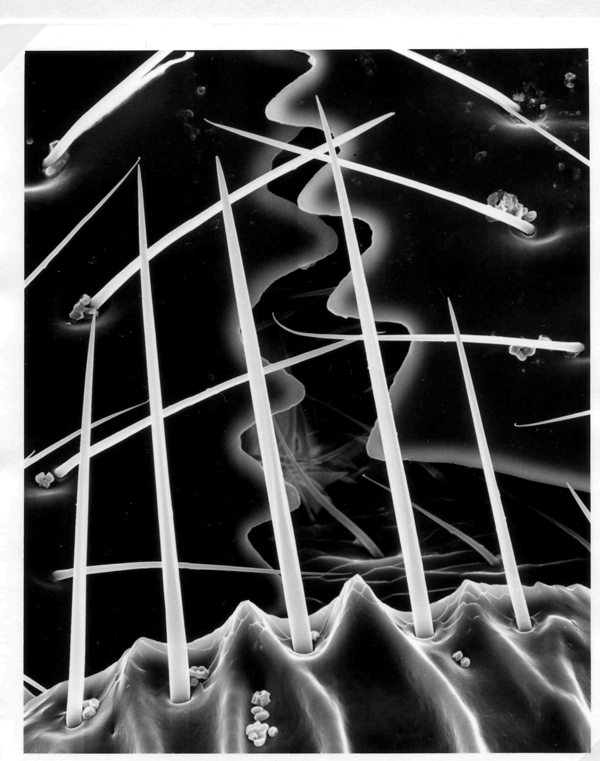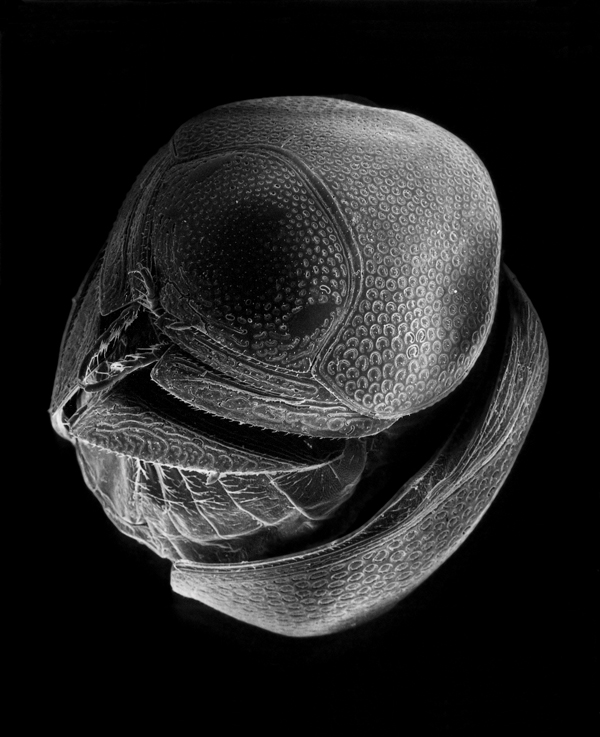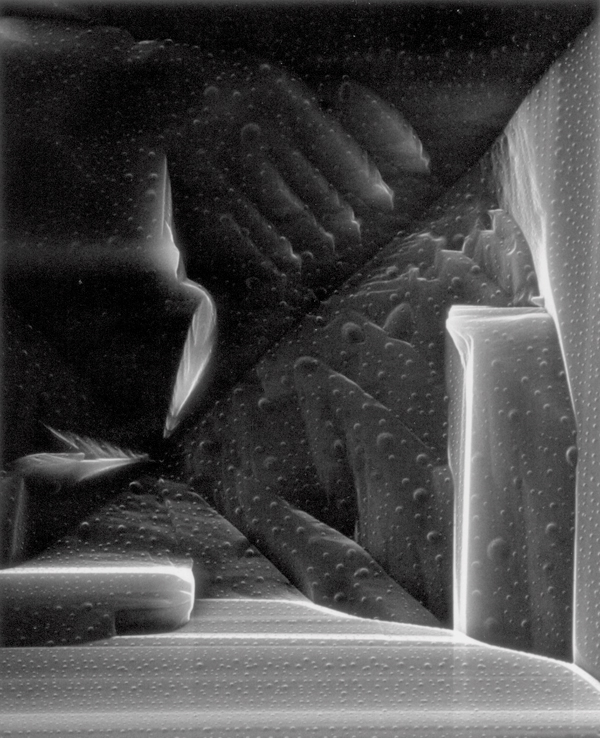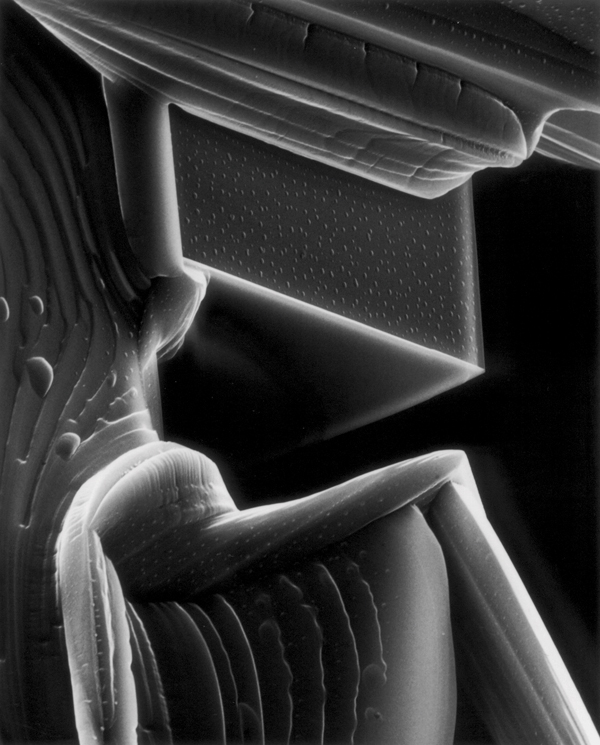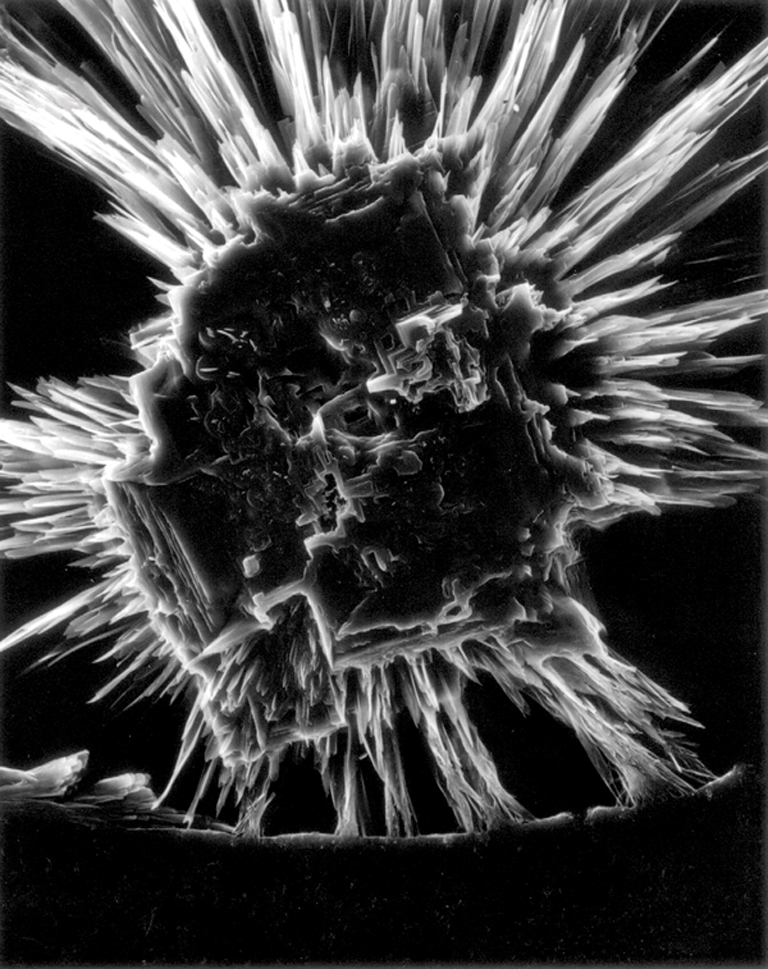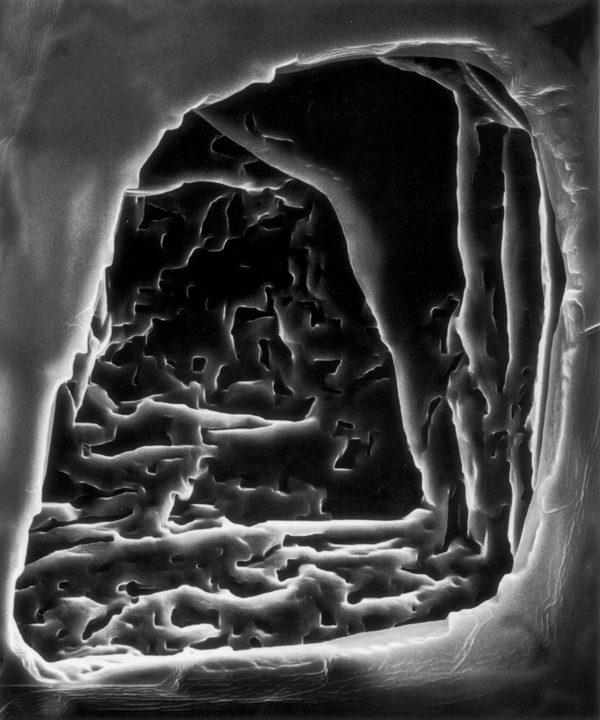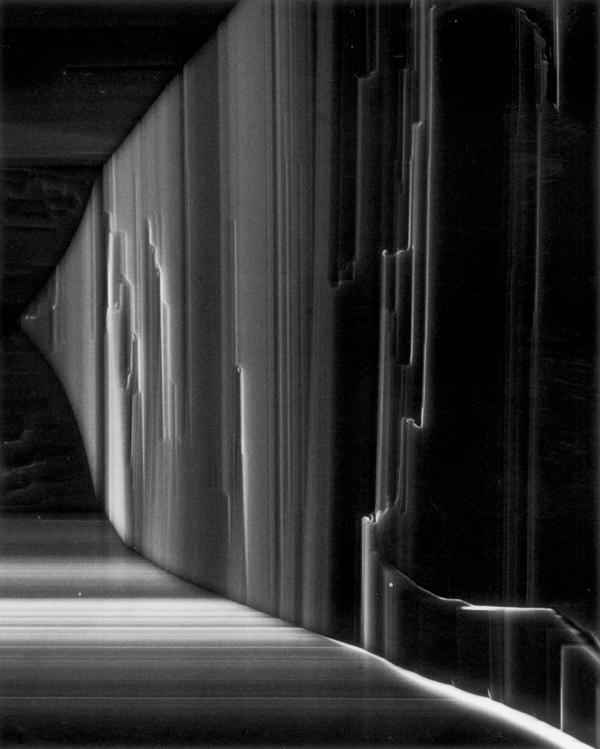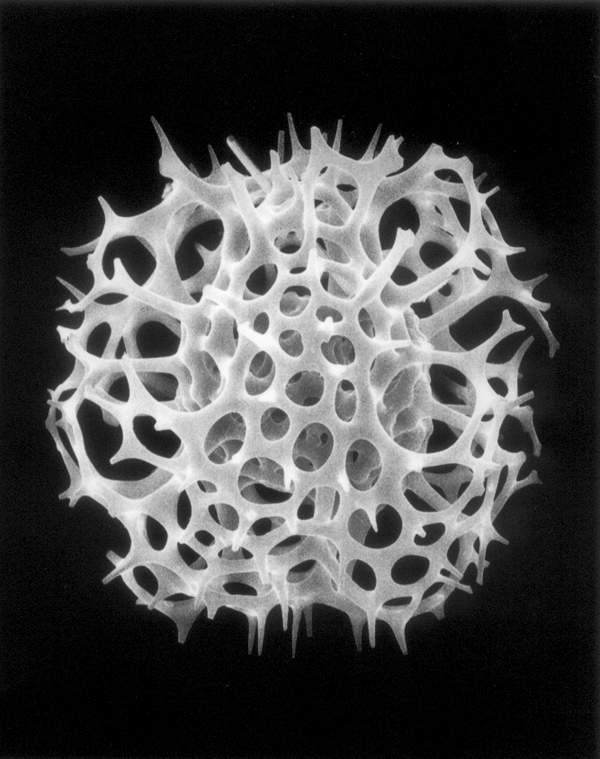[Winter 2005-2006]
by AnnThomas
An interest in the aesthetic and decorative potential of the photomicrograph was expressed as early as 1858, when an observer noted, “Any one who will look at a set of illustrations of the Diatomaceae or Desmidiaceae will at once perceive the suitableness of many of their forms for decorative purposes.”1
In fact, the highly unlikely subject of the image of diatoms serving to inspire artistic creation would escalate in the early decades of the twentieth century into something of a fantasy of intensely detailed symmetrical forms. The first exposure to the startling beauties of the photomicrograph for many photographer-artists of this generation would have been through the viewing of very large, projected images using lantern slides in darkened rooms, an instructional aid pervasive in universities in the late nineteenth century and the early decades of the twentieth. The sheer beauty of the forms revealed under the microscope inspired a number of photographers known for their exceptional treatment of other subjects, such as architecture and portraiture, to experiment with photomicrography.
By the 1920s and 1930s, the technology that drove this kind of experimentation had made significant advances. In France, photographer Laure Albin Guillot (1879–1962) published a portfolio of photogravures, Micrographie décorative, in 1931, that surely represents the epitome of decorative micrography. Printed with metallic inks, the sheets in this portfolio present a shimmering, richly patterned array of complex, interlocking, repeating forms.
But as far as pervasive use of photomicrography for a range of artistic expression was concerned, in the twentieth century Germany was the country in which it enjoyed the greatest popularity. There were several main factors contributing to this development.
There was accelerated progress in the development of lenses and attachments for both cameras and microscopes, and technical information about photomicrography and its imagery was widely disseminated through publications and lanternslide projections. This resulted in a popularization of the practice and in an increased appreciation for scientific imagery. It was also acknowledged in Germany, where the most significant advances in optical technology had occurred, that by late 1937 the market for photomicrographic materials was not limited to professional scientists working in a laboratory but included photographers and artists.
While it is true that a climate of receptivity toward scientifically oriented art photographs was established in the 1920s by Karl Blossfeldt’s (1865–1932) magnificent Urformen der Kunst (1928) and Albert Renger-Patzsch’s (1897–1966) Der Welt ist schön (1928), it must be said that it was probably not these images that inspired German photographers of the 1920s and 1930s to create decorative photomicrographs, but the exquisite drawings of the microscopic forms of radiolae and protozoa by German protozoologist Ernst Haeckel (1834–1919). Haeckel’s impact on the visual arts in Germany was appreciable as he brought the symmetries and abstract intricacies of these micro-organisms to a larger public.2. His name and work were repeatedly invoked as representing a desirable standard of accomplishment in articles that appeared in German magazines on the subject of photomicrography in the 1920s and 1930s.
But while Haeckel’s illustrations may have inspired a decorative approach to the micrograph, there was clearly another influence being exerted simultaneously on photographers in Germany at this time. An august list of German photographers can be invoked to support the extent of this interest: Carl Strüwe (1898–1988), Alfred Ehrhardt (1901–84), Herbert Schürmann (1908–82), Anton Stankowski (1906–99), Ernst Fuhrmann (1866–1956), and August Kreyenkamp (1875–1950). While these photographers shared an appreciation of photomicrography, they did not necessarily approach its usage with the same philosophical viewpoints. Some were more drawn to the biomorphic and spiritual aspect of photographing organisms up close, while others saw the artistic use of the microscope as subverting the ascension of technology as an end in itself. As critic and photographer Franz Roh (1890–1965) expressed it, “Finally, we capture the world of the microscope, not just for scientific reasons, but also with elemental amazement at the wondrous forms of the microcosm.”3
In addition to Blossfeldt’s and Renger-Patzsch’s responses to the cool, sharp-edged authority of scientific imagery, there was also a growing influence on the photographic aesthetic by industrial objects and images, with their emphasis on surface textures and dynamic composition. By the mid-1920s, German avant-garde photographers, who were less oriented toward the decorative aesthetic and more concerned with advancing new ideas about form and a renewed relationship with the contemporary world, including industry, were incorporating photomicrography into their visual repertoires. Fascinated by the structures that improved lens technology was now making visible to the human eye, advocates of the New Vision saw every reason to include the microcosm in their exploration of form. Laszló Moholy-Nagy’s highly influential book, a kind of manifesto for the New Vision, Malerei, photographie, film (1925), included examples of photomicrographs and X-ray images as a counterbalance to what he considered to be the soft conventions of pictorialism. In this publication Moholy-Nagy compares the objective and non-objective worlds. “Man’s interest in getting to know the whole world,” he wrote, “has been enlarged by the feeling of being – at every moment – in every situation – involved in it.”4
For Moholy-Nagy, it was “not enough” that the medium of photography had gained increasing attention and was proliferating as a medium of artistic expression. What was important for him, and what he viewed as lacking in the products of the new visual technologies, was the visible evidence of photographic images that spoke to a new relationship being forged between humankind and the outside world. “We may say that we see the world with entirely different eyes,” he wrote.5 And further on in the text he emphasizes the role of art in creating “new relationships”: “Art attempts to establish far reaching new relationships between the known and the as yet unknown optical, acoustical, and other functional phenomena.”6 To illustrate his point about the inclusion of new references, Moholy-Nagy reproduced a number of scientific photographs, including those that pictured astronomical and entomological phenomena and specimens, as well as radiographic images.7 Franz Roh and Jan Tschichold’s 1929 publication, Foto-Auge: 76 photos der Zeit = Œil et photo : 76 photographies de notre temps = Photo-eye: 76 photoes [sic] of the period / zusammengestellt von Franz Roh und Jan Tschichold, would do likewise. Closely allied with Moholy-Nagy’s New Vision were the photographers associated with the art movement in Germany known as the New Objectivity, who abandoned soft-focus sentimental imagery for more crisply formed images of the material world.
By the mid-twentieth century, a revolution had occurred in photomicroscopy. The electron microscope, which first became commercially available in 1935, was subjected to a rapid series of refinements over the next five years, to the point that it could enlarge to fifty times the magnification of the best light microscope. This would herald new technologies that we possess today, such as the scanning electron microscope, which not only has an extremely high resolving power but also reproduces the nooks and crannies in the micro world with an astounding sense of three-dimensionality.
It is this advance that has made Claudia Fährenkemper’s pristine, greatly enlarged photomicrographs of insects technically possible, and her unusual vision that has made their precision and fine formal and technical realization so visually compelling. Her images are distinguished from the typical entomological, zoological, and mineral photomicrographic textbook illustrations by her awareness of the architectonic, organic, and spatial possibilities of the specimens she photographs. Furthermore, she demonstrates a capacity to transform their details into something that appears to exist in isolation from their biological function. While playing simultaneously and ambiguously with the notions of the beautiful and the grotesque in all of these photographs, which range from low magnifications of a factor of thirty times to a factor of three thousand times the size of the specimen, Fährenkemper ensures that we will be attracted to a different aspect of the microstructure in each one.
Exploring three principal subjects in this body of work – insects (Imago), plankton (Planktos), and crystals (Habitus) – Fährenkemper revels in the uncommon formal relationships that she observes in the microcosmic universe. In Imago she brings to the forefront the delicate shapes that represent the sensual and sensory organs of beetles, such as in Sensory Hair of a Beetle. Her close-up examination of these forms often endows the subject with sensuality reminiscent of the paintings of Georgia O’Keeffe. Wing and Wing Covers of a Beetle attracts us because of its extraordinarily complex, intricate, and diverse architecture of horizontal strata and interconnecting shapes, which fold over and into each other. Like a warrior’s suit of armour, the heavily cladded body of the insect in Beetle is strongly sculptural and Fährenkemper’s image draws our attention to the intricacy and purposefulness of design in nature.
If the Imago series emphasizes architectonic form, the Habitus images introduce the viewer to a world of exploding crystalline forms. Transparent, lucid, and dynamic, they are suggestive of unearthly landscapes and cosmic bodies, the stuff of science fiction. The intricate forms of the images that comprise Planktos, on the other hand, have a jewel-like presence. Isolated against a black background, their distinctive object quality is captured through precise detailing of their individual surface textures and expression of their internal luminosity.
While the neutrality of presentation, clarity of expression, and emphasis on the revelation of structure seen in Blossfeldt’s work are also evident in Fährenkemper’s photographs, she is less interested in a concept of archetypal forms in nature that instruct us in a theory of unified aesthetics in art. Her vision would appear closer to Max Ernst’s surrealist sense of the microcosm, in its creation of a parallel world of previously unimagined shapes and forms.
A student of Bernd Becher’s at the Art Academy in Düsseldorf, Claudia Fährenkemper has succeeded in achieving a monumentality of form with her interpretations of microscopic views of insects that rivals some of the stunning photographs of pithead structures made by her teacher and his partner, Hilla Becher. Like her predecessors, Karl Blossfeldt and Albert Renger=Patzsch, Fährenkemper has borrowed the tools and analytical values of scientific investigation to make art. In the end it is not the scientific significance that has meaning for her, but the ability of the image to interpret this new relationship with the microcosmic world, to represent for the viewer a sensual experience of the perfect and complex tiny forms that constitute its inhabitants.
A longer version of this essay originally appeared in Claudia Fährenkemper. Photomicrographs (Hatje Cantz Verlag, 2004).
1 C. J. Burnett, “On the Application of Photography to Botanical and Other Book Illustration,” Liverpool and Manchester Photographic Journal, Vol. 2, No. 18 (Sept. 15, 1858): 227.
2 Protozoology, like the study of cryptogams, looked at simple life forms. This area of study attracted a great deal of attention in the nineteenth century, particularly after the publication of Darwin’s On the Origin of Species by Means of Natural Selection in 1859, because of the role that these unicellular beings might possibly play in determining a stage in the evolutionary path between the plant and animal worlds. The topicality of the subject would explain in part the fascination that it held for photomicrographers who were not practising scientists.
3 Franz Roh, “The Value of Photography,” in Christopher Phillips (ed.), Photography in the Modern Era: European Documents and Critical Writings, 1913–1940 (New York: Metropolitan Museum of Art, Aperture, 1989), p. 161 (orig. publication: Franz Roh “Der Wert der Photographie,” Mittelungsblatt der Pfälzischen Landesgewerbeanstalt 1 [February 1930]).
4 Laszló Moholy-Nagy, Painting, Photography, Film (Cambridge: MIT, 1973), p. 15; boldface in original. A translated paperback edition of Malerei, Fotografie, Film, which appeared in 1925 as volume 8 in the Bauhausbucher. A second edition was published in 1927.
5 Ibid., p. 29; boldface in original.
6 Ibid., p.30.
7 Cirrous feet of a barnacle by F. M. Duncan (p. 52) and enlarged photograph of a head louse (also p. 52). He also reproduced a close-up view of a Cactus by Renger-Patzsch (p. 91).
Taken with a scanning electron microscope, Claudia Fährenkemper’s photographs provide a sensual encounter with the microcosm and its morphological detailing. They propose a sculptural and spatial experience that leads to a renewed understanding of our environment and reality. Her work has been shown in Germany, Switzerland and Canada. Claudia Fährenkemper lives and works in Bonn and Lünen, Germany. She is represented by Galerie Poller, in Frankfurt.www.galerie-poller.com
Ann Thomas is Curator of Photographs, National Gallery of Canada. Her interest in the incorporation of scientific imaging processes into the making of art resulted in her production of the exhibition and book Photography in Science: Beauty of Another Order (Ottawa: Yale University Press and National Gallery of Canada, 1997) and “Interpreting the Microcosm through Photographs,” in Claudia Fährenkemper. Photomicrographs (Hatje Cantz Verlag, 2004).

